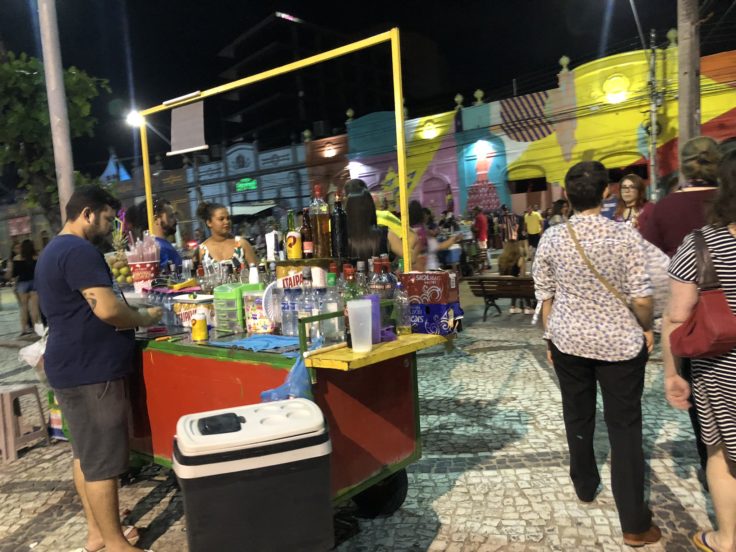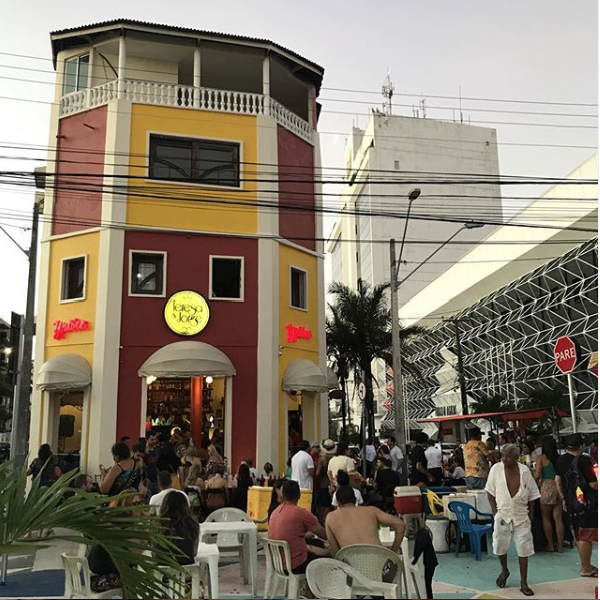August 20, 2019
What is the Opposite of Broken Windows?
Fortaleza’s pedestrian interventions demonstrate how safe and aesthetic cities can improve quality of life.
Safer streets mean happier people, more foot traffic, and civic pride
Fortaleza, a city of 3 million in Brazil’s northeast coast, and like many other Brazilian cities, had been plagued by staggering rates of traffic fatalities. Today, the city is hailed as a best practice, having reduced traffic related injuries and deaths by a 40 percent, along with a significant increase in bikes and public transport ridership. There are many reasons for Fortaleza’s success, such as political courage, smart policies, and a major commitment to improving public transport. Yet, the biggest and most visible change is the literal transformation of the city streets. Unlike the theory of broken windows – which espouses that any ‘visible’ signs of criminality, like broken windows on an abandoned building, can lead to more serious crimes – keeping streets clean and removing signs of ‘lesser crimes’ deters more major crimes from occurring. In Fortaleza, deterrence was not the objective. Rather, improved spaces were also made more beautiful and this aesthetic upgrade led to more engagement and happier people.
ITDP has long advocated for putting pedestrians first, and the streets of Fortaleza show how it can be done. Just as important as the technical aspects, however, is what it means for people to see and use these streets differently. Better, safer, and more attractive streets mean more space for people, more foot traffic, a better quality of life, and for Fortaleza, a surge of civic pride.
While the pedestrian and street interventions were billed as temporary measures, many like Cidade 2000, Dragão do Mar, and the area near the Albert Sabin Children’s Hospital, became permanent due to public enthusiasm. Despite initial public hesitation and pushback, people’s minds were changed when they saw how safe and pleasant these spaces had become.


Safe crossings are crucial to a functional city, but safe spaces are foundational for a thriving community.
Building or expanding sidewalks alone gave these districts new life and new energy, allowing not only safety to those circulating, but creating space for people to use economically as well. Giving people a true feeling of safety has demonstrated how much potential these spaces possess.


Having space and safety from the onslaught of dangerous motor vehicles, informal vendors are free to sell cocktails at night in Dragão do Mar to patrons of the many bars nearby.
Pedestrians First Means Children First
A major emphasis of the interventions was the prioritization of children, an initiative notably championed by the First Lady of Fortaleza. Cidade 2000, a residential neighborhood near the center of Fortaleza, received a temporary intervention called “Cidade de Gente” or “City for People”. The intervention included painting a part of the central through way and blocking vehicular traffic to create a central plaza that people could gather in. Prior to the temporary intervention, the organizers (from NACTO-GDCI and Bloomberg Initiative for Global Road Safety) asked vendors who created playgrounds for children to bring in trampolines and other playground toys for kids. The vendors originally declined because they believed the space to be dangerous for children. Indeed, people reported feeling unsafe and very unsafe in the area because of the high occurrence of motorized traffic. However, after just the first day of intervention, and witnessing the popularity among people around the neighborhood, not to mention witnessing how safe the space actually was, the vendors immediately changed course and brought in games for children.


Cidade 2000 has become a favorite spot for the neighborhood’s children and families. Parents have reported that they now use a visit to the plaza as a reward for their children for finishing homework or chores. This area would have never been deemed a desirable location for people, yet alone children to pass time in, but there is a clear enthusiasm among people of the neighborhood. Indeed, there is an increase by 70% of people reporting that they feel safer in the area. Additionally, there is a 350% increase in pedestrians walking around that area with an increase of over 60% of children. While these interventions were met with skepticism, after their introduction, the mentality and mindsets of residents changed as their participation and enthusiasm for those spaces increased. Cidade 2000 demonstrates that a safe space transforms into a cared for area.
The Opposite of Broken Windows: The Aesthetic Domino Effect
For years, sustainable transport advocates and urban planners have talked about the power of street beautification and Fortaleza illustrates one example of why. Beauty can have an effect on people’s use of the space. For this reason, painting streets and intersections is becoming a common practice in cities looking to shape and transform their streets.
Once they have become permanent, these projects in Fortaleza have drawn attention and participation by a wider public. For example, people naturally seek attractive and eye catching backgrounds for photos, and many of the repainted districts and areas have created ideal backdrops for pictures. Each photo on Instagram was discovered using a search by location, meaning people are proudly associating with the city and neighborhood they’re in.
There is a popular bar called Teresa & Jorge that is in front of a triangular intersection that was chosen for an intervention.


When this partial intersection was painted, it become a more popular gathering place, which was not surprising as it was directly across a popular bar and bringing drinks outside is legal in Brazil.


Either the foot traffic or the juxtaposition against such a bright section, or both, created a domino effect in which the building’s aesthetic improved after the urban intervention. Additionally, the bar has adopted the new plaza as part of a citywide Plaza Adoption Program.
About Fortaleza’s Intervention
Thanks to its creative interventions, Fortaleza won the 2019 Sustainable Transport Award and hosted the MOBILIZE Summit in 2019. Fortaleza focused on interventions in multiple arenas – public transportation improvements including enhanced multimodal terminals, over 200 kilometers of bike lanes and different bikeshare programs (depending on distance and need), as well as pedestrian enhancements. Through temporary interventions, Fortaleza demonstrated the value of public space, an essential part of any people-centered city. Temporary interventions, such as Cidade da Gente, which transformed a parking lot and traffic lanes into a pedestrian area, showed what is possible. Reduced speed limit interventions in certain areas, and improved street design, which includes making traffic lanes narrower, and raising crosswalks to make them more visible, have also contributed to safety.
Fortaleza created “complete streets”, with more equal space dedicated to all road users, rather than making streets only for cars. They built new right-of-way for their buses, adding 111 kilometers of bus-only lanes, with refurbished bus terminals, and a fare-integrated system with the light rail, making the bus experience faster, safer, and more comfortable. These interventions increased the average bus speed from 4 km/h to 14 km/h, and is saving nine tons of C02 per day. All city buses have Wi-Fi, and an increasing number have air conditioning.
Read more about Fortaleza’s interventions that won the STA and how MOBILIZE was a perfect showcase for the extensive work performed in the city.



